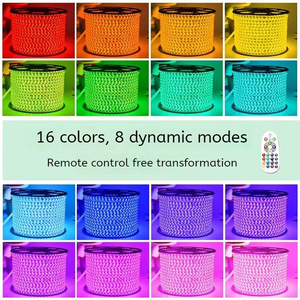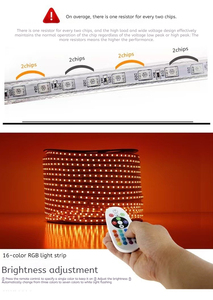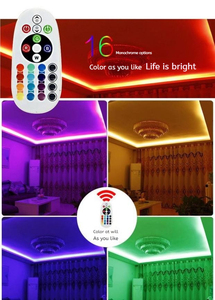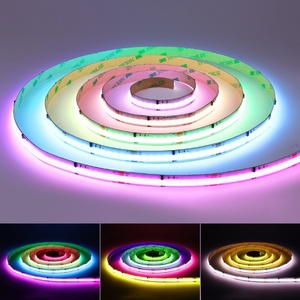(75816 products available)



















































































































































































































Smart strips are available in one of several configurations to suit each user's requirements, which is particularly important for commercial users. Several kinds of operational features, the power management protocols they employ, and the physical arrangement of electric outlets led to this sector's division. The classification of intelligent strips according to their operation and characteristics may be aided by analyzing the following criteria.
Turn Intelligent Strips On/Off Automatically
Outlets on intelligent strips can be turned on or off based on how many connected devices are in use. These kinds are handy in workstations or meeting rooms, where desktops, laptops, and AV devices should only occasionally need power. Many load-sensing strips monitor the power demand of connected devices and switch off individual outlets when the equipment plugged in no longer requires power. This helps prevent power wastage and prolongs the life of electronic devices.
Strip with Programmable Sockets and Timer Settings
Programmable intelligent strips are more flexible, allowing users to set specific times for turning outlets on or off. These are useful in retail environments for controlling display lighting or in offices where devices need to be powered down after work hours. The ability to create a schedule helps reduce energy consumption and automates power management without the need for constant monitoring.
Centrally Controllable Strips
Centralized intelligent strips can be managed through a single control system, such as a building management system (BMS) or a smartphone app. This is especially helpful for large-scale enterprises that need to manage numerous strips in different locations. These kinds of strips offer real-time power monitoring, the ability to turn outlets on and off remotely, and detailed energy usage reports.
Smart Strips with Surge Protection
Surge-protecting intelligent strips are designed to safeguard connected devices from voltage spikes. This is particularly important in environments where sensitive equipment, such as computers and medical devices, is used. Modern surge protector strips also come equipped with smart capabilities, such as energy monitoring and the ability to control outlets through mobile applications.
The materials employed to manufacture intelligent strips determine their efficiency, endurance, and safety features. From the outlets to the internal components, every part of a smart strip is designed with careful consideration for its intended use and environment.
Plastic Enclosure
The outer casing of most smart strips is made from durable plastics, such as polycarbonate or ABS (acrylonitrile butadiene styrene). These materials are lightweight, impact-resistant, and provide a good barrier against electrical hazards. ABS is favored for its balance between rigidity and flexibility, which allows the strip to endure stress without cracking. The plastic enclosure is designed to ensure that the internal wiring and components are safely contained, reducing the risk of electric shock.
Metallic Parts for Conductivity
Smart strips contain internal wiring and connectors made from copper or copper alloys. These metals are chosen due to their excellent electrical conductivity, ensuring minimal energy loss during power transmission. Copper connectors are often plated with nickel or tin to prevent corrosion and enhance durability. Nickel plating also provides improved solderability for manufacturing.
Surge Protection Components
Smart strips with surge protection procedures frequently integrate metal oxide varistors (MOVs) or gas discharge tubes (GDTs) in their designs. Silicon carbide is one of the most prevalent semiconducting materials composed of these components. When an excessive voltage occurs, these materials work by diverting the extra electricity away from connected devices, hence preventing damage. MOVs are typically constructed with ceramic powder and zinc oxide varistors, which are the ceramic discs that form the cores of electrical surge protectors.
Heat-Resistant Materials
Because intelligent strips endure continual use, heat-resistant materials are frequently employed in their design. Two of the most widely used thermal polymers in these applications are polyamide (nylon) and polyimide. These materials are helpful where high-power devices are plugged in because they guarantee the strip can survive prolonged heat exposure without deforming or losing effectiveness.
Smart Technology Components
The addition of smart technologies increases the number of materials used in making intelligent strips. These strips frequently include circuit boards made of epoxy fiberglass (FR4), which supports the many electronic sensors, microcontrollers, and communication modules. FR4 is a sturdy, heat-resistant base material for circuit boards suitable for complex electronic configurations.
Smart strips are frequently employed in various settings, including workplace environments, educational institutions, and commercial facilities. These strips promote efficiency when managing power use as the demand for energy efficiency increases. The following is a list of commercial applications that illustrate how intelligent strips are utilized.
Office Power Management
A common application for intelligent strips is in office power management. Computers, printers, and other office equipment require considerable power consumption to run. Intelligent strips can be used to cut power to devices at the end of the workday automatically, hence stopping operation and avoiding energy waste. In some instances, strips that are load sensing will only turn off the power to an outlet when the item plugged into that outlet no longer draws any electricity.
Retail and Commercial Spaces
In retail environments, intelligent strips can control the lighting and other display equipment. Using programmable strips, retailers can set the lighting to turn on or off at specified times, ensuring that displays are always well-lit at appropriate times. This can increase the impact of the first impression and conserve energy during non-peak hours. Additionally, intelligent strips with surge protection can secure costly electronic displays against power disturbances.
Conference Rooms and Workspaces
Intelligent strips are often installed in conference rooms and collaborative workspaces to manage audiovisual (AV) equipment and other devices. These strips can be controlled centrally or programmed to turn off, preventing users from forgetting to power down devices after use. This not only saves energy but also extends the lifespan of the devices by reducing wear and tear.
Educational Institutions
Schools and universities can benefit significantly from deploying smart strips. In computer labs, libraries, and classrooms, intelligent strips help ensure that groups of devices, such as computers and projectors, are powered down collectively when not in use. This reduces energy costs and helps teach students about the importance of energy conservation.
Industrial and Manufacturing Settings
Manufacturing facilities frequently utilize high-powered equipment that demands careful power management. Smart strips with load sensing and surge protection are helpful in these situations to secure machines from power spikes and ensure that only necessary devices receive power. These strips integrate with existing industrial control systems to provide real-time monitoring and management of power usage.
Selecting the most fit intelligent strip for a company incorporates thinking through how it will help reduce operating costs, plus the benefits of surge protection and coordinating power demands with usage. The following criteria will help navigate these decisions more easily by outlining the key considerations when choosing a smart strip.
Power Needs
The intelligent strip's rated power capacity must meet the requirements of all devices that a company intends to connect. High-load appliances like projectors, printers, and coffee makers frequently used in commercial settings need a strip with a strong electrical outlet configuration. Users should also check that the smart strip can handle the power requirements of each connected device to prevent overheating and power surges.
Energy Efficiency Features
Intelligent strips are designed to cut down on energy waste, particularly in settings with many computers and electronic devices. To further enhance energy savings, look for strips with occupancy sensors, auto power-off capabilities, and load balancing. These elements contribute to the efficient use of power and the reduction of energy costs.
Surge Protection
Consider intelligent strips with surge protection if the business relies on sensitive electronic equipment. Power surges and voltage fluctuations can damage hardware, resulting in downtime and replacement costs. Smart strips with integrated surge protection safeguard connected devices and improve their overall reliability and durability.
Certifications and Compliance
Verify that the smart strip meets industry standards for safety and energy efficiency, such as UL (Underwriters Laboratories) or ENERGY STAR certification. These certifications ensure that the strip has been tested for safety and compliance with energy-saving standards, reducing the risk of electrical hazards and contributing to sustainability goals.
Compatibility with Existing Systems
In large commercial settings, it may be necessary to control multiple smart strips from a central system. Ensure that the chosen strip is compatible with existing building management systems (BMS) or other central control solutions. This allows for unified power management and monitoring across the entire facility.
Load-sensing lite bars help to cut down on electrical waste in business because only devices that require power at any given time get supplied with power are.
Yes, delegating tasks to larger smart strips through BMSs or other central management systems that many firms already have is a feasible option.
Intelligent strips with surge protection are well worth the cost, particularly for businesses that rely on expensive electronic equipment, as they help prevent damage from power surges.
One should check the smart strip's power capacity, energy-saving features, surge protection, certifications, and compatibility with existing systems before deciding.
One can save up to 30% on their power bill by using intelligent strips with energy-saving features, like load sensing and automatic power shut-off.
Smart strips provide an effective way to manage power consumption, protect against surges, and mitigate costs in commercial applications. By understanding their types, materials, commercial uses, and how to choose them, businesses can make informed decisions that enhance their operational efficiency and safeguard their valuable equipment.